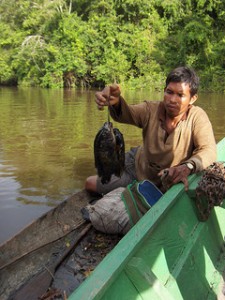
The Amazon River (Cr: Chico75 via. Wikipedia Commons)
As humans continue to advance in technology and grow industrially, we are also emitting harmful substances to the environment. Over a long period of time, the environment around us will continue to worsen unless we become active and do something to stop it. After all, changes in the environment are slow and gradual processes, despite it being sped up in the past few decades.

A very basic look at the freshwater ecosystems. From Youtube user: greatpacificmedia.
Recently, researchers found that freshwater ecosystems in the Amazon are highly vulnerable to environmental degradation. Pollution, deforestation, construction of dams and waterways, as well as over-harvesting of plant and animal species are increasingly degrading the many types of ecosystems in the Amazon, including river, lake and wetland ecosystems. The different ecosystems take up approximately one-fifth of the Amazon basin area.
The damage to the Amazon freshwater systems not only affects the balance to the environment, but also affects the Amazonians. They have historically been so dependent on the water system that they are called the ‘water peoples.’ The current consumption of fish per capita is approximately 94 kg/yr for the people who live by the rivers, which is about six times the world average. The size of the fish harvested have shrunk, mainly due to continual harvesting of high-value, large-bodied species. The difference in mean sizes (maximum body length) of fish today compared to fish from a century ago is about 126 cm. That is a huge difference.
While there has been many studies done in the Amazon, they are mainly focused on forests and their associated biodiversity and carbon effects. Three decades of research led to an establishment of protected areas, designed to protect the forest and the biodiversity. There is little attention paid to freshwater ecosystems, which is connected to other ecosystems through the water cycle.

An example of a hydro dam. The Three Gorges Dam in the Yangtze River in China (Cr. Rehman via. Wikipedia Commons)
The main threat to most of the Amazon freshwater ecosystems is the large-scale change to the area’s hydrology. There are a total of 154 hydroelectric dams working in the area, with 21 in construction and 227 more dams to be built in the future. Some researchers say that the amount of construction, if uncontrolled, will have a negative impact fish migration and the associated fishery yields. It will ultimately threaten life and food security.
For better protection of the Amazon freshwater systems, it requires people to actively include the water systems into the current forest-centric focus of environmental management. And while understanding the changes in the environment will help, it is probably better for our future if people become more active in environmental protection.
Maggie Chan

